Athena in Art: The Beautiful Warrior Goddess
Athena, the revered Greek goddess of wisdom, war and the arts, has captivated the imagination of artists for centuries. Her image, from ancient...
Jimena Aullet 15 August 2024
Mythological heroes have been depicted in artworks countless times throughout history. We are constantly returning to their timeless tales in art and literature. Myths are also not set in stone; they can be re-examined, bringing new takes on various heroes to life. Here we’ll look at a selection—the victorious and the tragic.
The demi-god Hercules—known as Heracles in Greek mythology—is synonymous with ideals of superhuman strength and victory. Whether found on the head of an ancient coin or in a zany Disney film, there have been many portrayals of his heroic deeds, such as the slaying of the hydra.
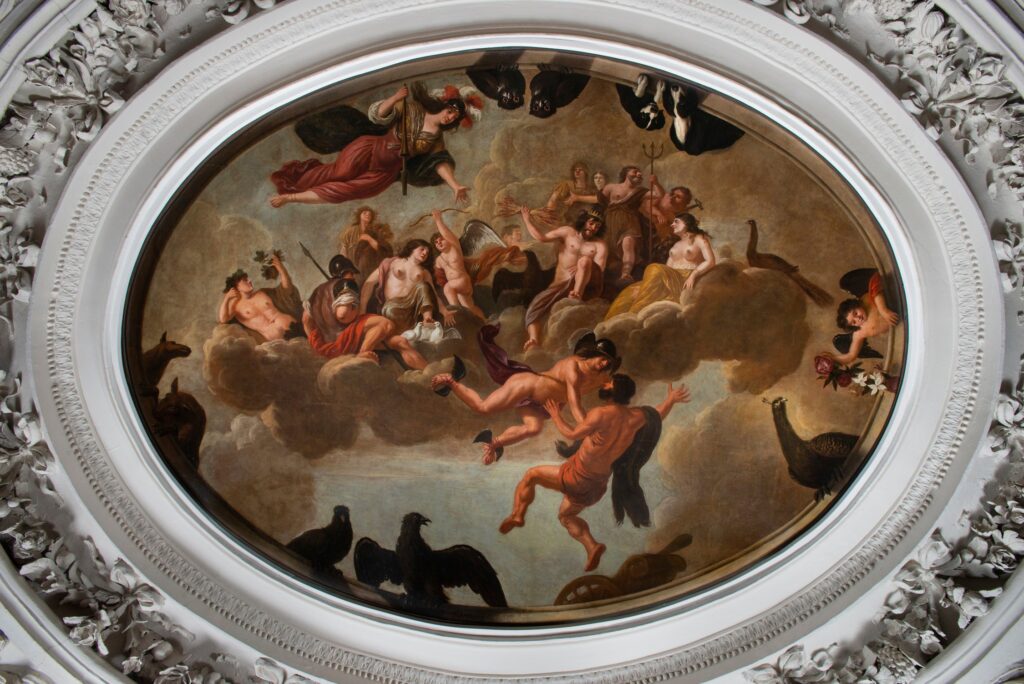
Jacob de Wet II, The Apotheosis of Hercules, 1675, Royal Collection Trust, Palace of Holyroodhouse, Edinburgh, UK. © His Majesty King Charles III 2023. Museum’s website.
The above artwork, The Apotheosis of Hercules, shows the reward that awaits Hercules after death. It is found on the ceiling of King Charles III’s bedchamber in the Palace of Holyroodhouse, Edinburgh, UK. The apotheosis refers to the ascension from morality to divinity. In other words, this work shows Hercules becoming a true god. In fact, there are more mythological heroes to be found. Many deities from Greek mythology make an appearance in this piece.
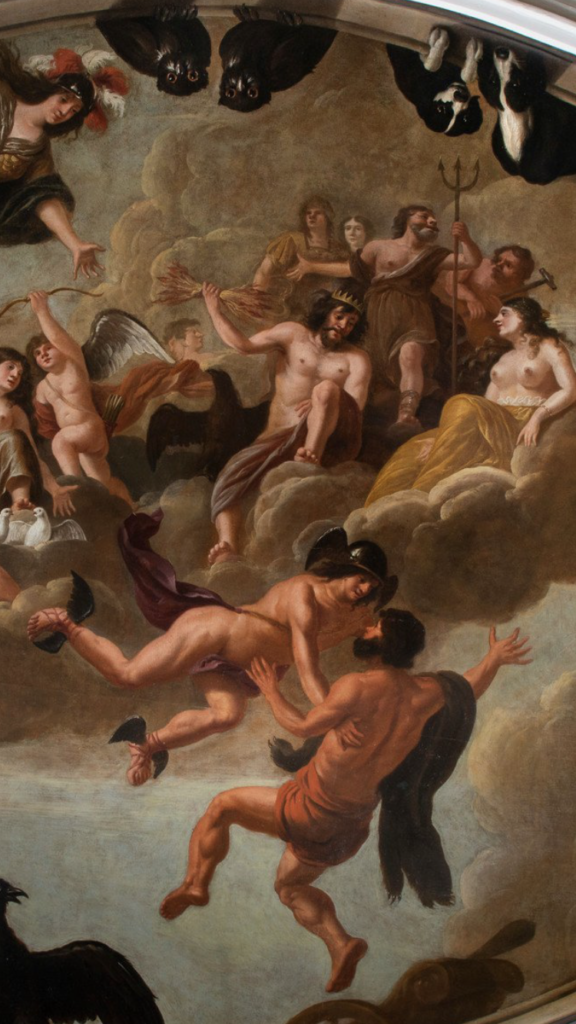
Jacob de Wet II, The Apotheosis of Hercules, 1675, Royal Collection Trust, Palace of Holyroodhouse, Edinburgh, UK. © His Majesty King Charles III 2023. Museum’s website. Detail.
This includes the winged messenger Hermes. He is shown fulfilling his role as a soul guide by pulling Hercules up to Mount Olympus, the seat of the gods. Hercules’ formidable father Zeus, the god of thunder, is also shown, crowned and wielding his lightning bolts.
Additionally, The Apotheosis of Hercules was frequently used as a vehicle to demonstrate the monarchy’s ‘divine right to rule.’ Comparisons were drawn between Hercules and certain members of royalty. The work in Holyroodhouse referred to Charles II’s rule over Scotland at the time. Other examples include the Hercules room in the Palace of Versailles, made for Louis XV of France.
Now we turn from ascending to the Heavens to stealing from them! So goes the legend of Titan god Prometheus. According to Greek mythology, Prometheus was responsible for fashioning the very first humans out of clay. In an act of defiance, he stole one of Zeus’ coveted lightning bolts in order to give mankind the gift of fire.
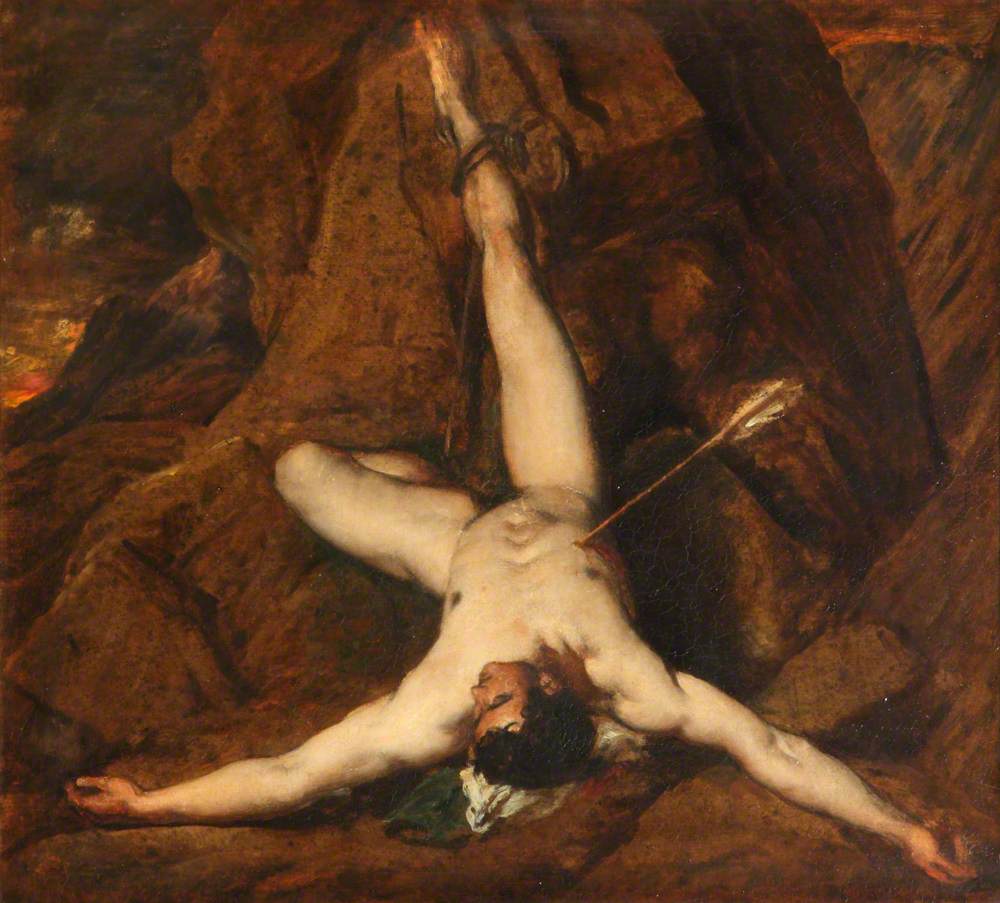
William Etty, Prometheus, late 1820s, Lady Lever Art Gallery, Wirral, UK. Art UK.
Prometheus by William Etty portrays a version of the god’s grisly end. As punishment for theft and deception, Zeus had Prometheus chained to the rocks, battered by waves. An eagle—one of Zeus’ symbols—would pick out Prometheus’ liver, which would then regrow for the torture to recommence over and over again.
Etty’s piece evokes inverted ‘Christ on the cross’ imagery, which ties into the theme of Prometheus sacrificing his own life for the good of humanity.
In many iterations, mythological heroes appear in the very same tale. There are versions where Prometheus is saved by none other than Hercules.
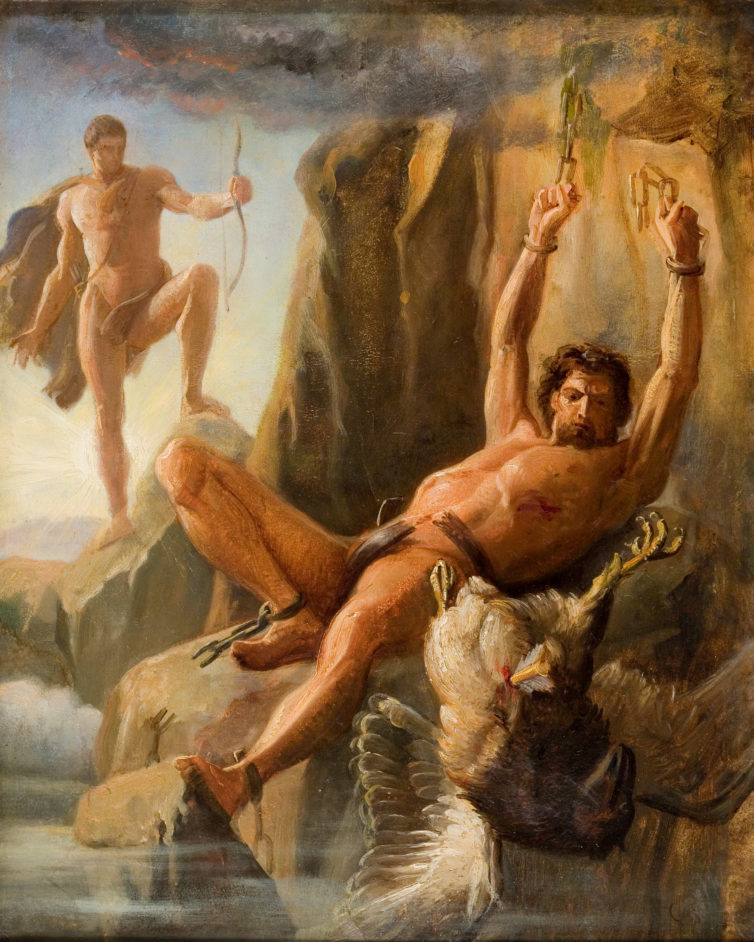
Carl Bloch, Liberation of Prometheus, 1864, Ribe Kunstmuseum, Denmark. Museum’s website.
As pictured in Carl Bloch’s painting, Hercules kills Zeus’ eagle and breaks Prometheus free. Rather than be furious, Zeus is impressed by his son’s act of strength. Seeing these two great mythological heroes existing in the same painting suggests that their fates are inextricably linked. In fact, freeing Prometheus may have been one of the feats that granted Hercules his reward in the afterlife.
Some tales inevitably end in tragedy. Indeed, Greek mythology contains the roots of many doomed romance stories, a trope that has never died. Our first pair of ill-fated lovers are Achilles and Patroclus. The phrase ‘Achilles heel’, used to mean a weakness that will bring about one’s demise, comes from the tale of Achilles’ death in the legendary Trojan War. Today, we’ll look at another Trojan War myth, one where an alive, grief-stricken Achilles mourns the death of another Greek hero: Patroclus.
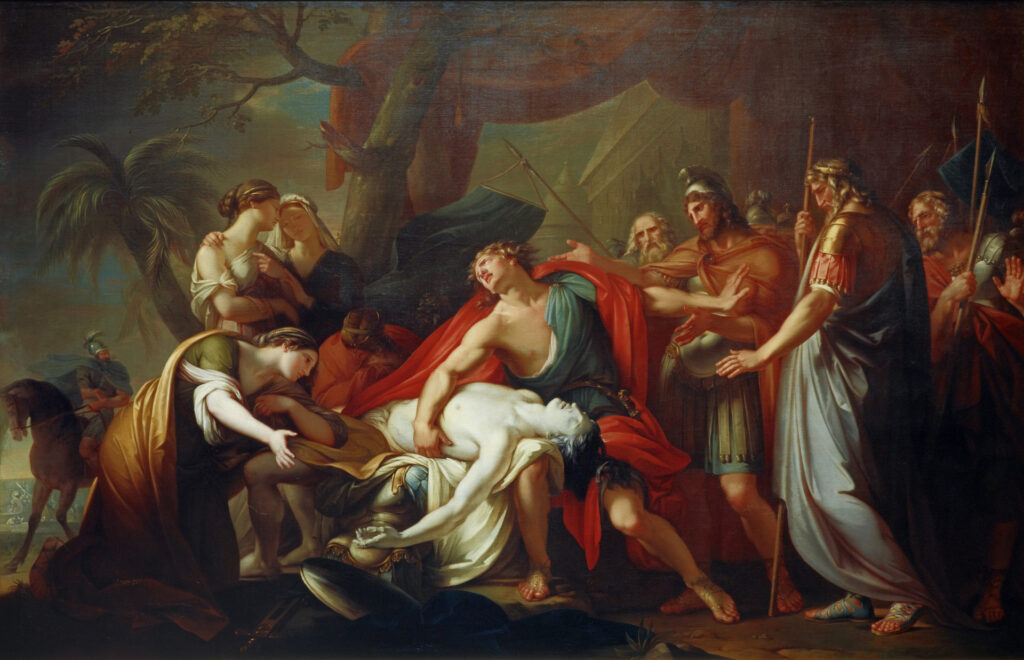
Gavin Hamilton, Achilles Lamenting the Death of Patroclus, 1760–1763, Scottish National Gallery, Edinburgh, UK.
He is half of my soul, as the poets say.
Madeline Miller, The Song of Achilles
This grand work, Achilles Lamenting the Death of Patroclus, encapsulates the tragedy of the scene, as Achilles discovers his dear friend has been killed by the Trojans. The emotion in his pose is evident, one hand struck out to bar his fellow warriors from reaching him. Furthermore, the fact that Achilles is baring more skin than the other soldiers adds to his vulnerability in grief. It could also be a comment on this Greek hero’s masculinity, as he is more ‘exposed’ and therefore symbolically more honest compared to those warriors perhaps hiding behind the armor. Certainly, Achilles’ relationship with Patroclus has often been interpreted as romantic, adding another layer of heartbreak to this tragic end.
Another classic tale of tragic love is the myth of Orpheus and Eurydice. When his lover Eurydice dies, Orpheus journeys into the underworld to rescue her. Powered by the strength of his love, he makes a deal with Hades, god of the dead, to ensure Eurydice’s safe return to Earth. However, there’s a catch. Eurydice has to walk behind Orpheus as they travel out of Hades’ realm; if Orpheus ever looks behind to check she is still there, she will belong to the underworld forever.
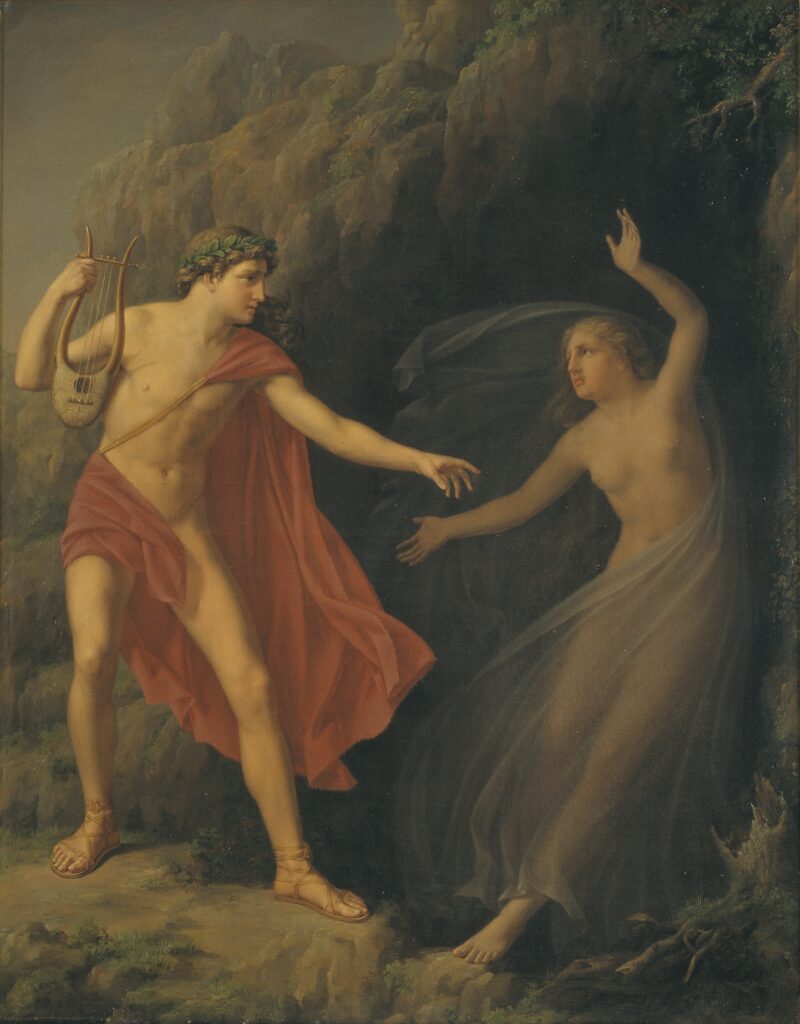
Carl Goos, Orpheus and Eurydice, 1826, National Gallery of Denmark, Copenhagen, Denmark.
However, plagued by doubt, Orpheus looks back. The dramatic moment is captured in this piece by Carl Goos. The ghostly veil wrapped around Eurydice already suggests that she belongs in the land of the dead.
And I’d be the immediate forgiveness in Eurydice.
Imagine being loved by me.
While this Greek myth has an undeniable tragic end, one perspective is that Eurydice’s last sight was proof of Orpheus’ adoration of her: so overwhelmed by love that it overcame all rational thought.
Finally, let’s consider some alternative looks at mythological heroes. Persephone’s story is often told as one concerning sexual violence, as she is abducted by Hades and made queen of the underworld. But there are versions of the myth where the relationship between Hades and Persephone is treated as a once ardent love gone sour.
For example, the musical Hadestown portrays a wistfulness between the two as they attempt to rekindle their relationship. The poignancy is clear through the fact that Persephone’s visits to Hades will always be fleeting: it’s said that her going to the underworld brings autumn, while her return to Earth brings spring.
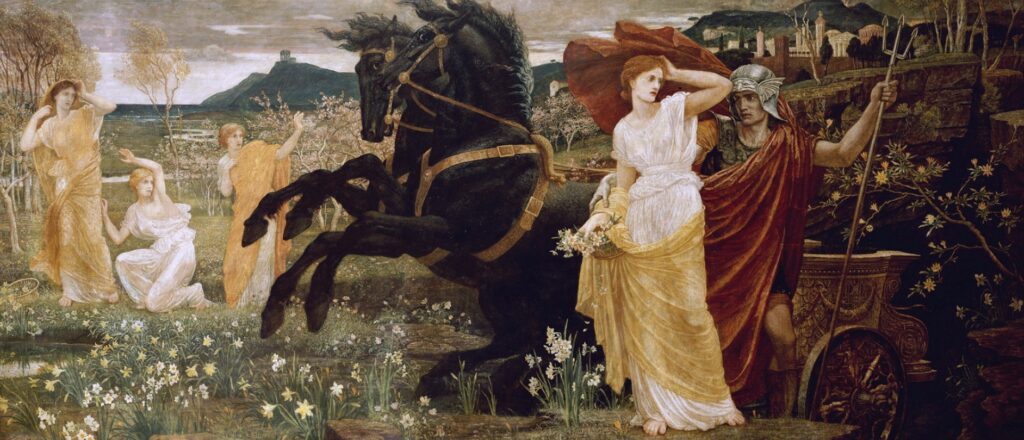
Walter Crane, The Fate of Persephone, 1877, private collection.
This artwork, The Fate of Persephone, depicts the arrival of an unearthly carriage, complete with formidable black horses: Persephone’s method of transport back down to the underworld. Whatever your reading of her relationship with Hades, the piece suggests heartache either way. The spring scene in the background, starkly contrasting with the black horses, suggests the ephemerality of the season. Persephone will soon get into the carriage, bringing with it the death of spring. However, conversely, the spring scene could be foreshadowing the temporary nature of Persephone’s life in the underworld. Even if she and Hades reconcile, she will always need to return to Earth, to herald spring.
PERSEPHONE: And how ‘bout you and I? Are we gonna try again?
HADES: It’s time for spring. We’ll try again next fall.
PERSEPHONE: Wait for me?
HADES: I will.
Wait For Me (Reprise) in Anaïs Mitchell, Hadestown (musical)
Just as Persephone’s fate could be viewed as necessary in order to bring balance between our seasons, something similar could be said for another Greek heroine: Pandora. In fact, her myth can be compared to the legend of Prometheus. Where Prometheus challenged Zeus and gave us fire, Pandora is commonly viewed as dooming humanity.
A popular version of her myth is that her insatiable curiosity was her downfall. Zeus gifted her a box (or jar, depending on various translations) and forbade her to open it. Of course, she did—and unleashed mortality and suffering into the world permanently.
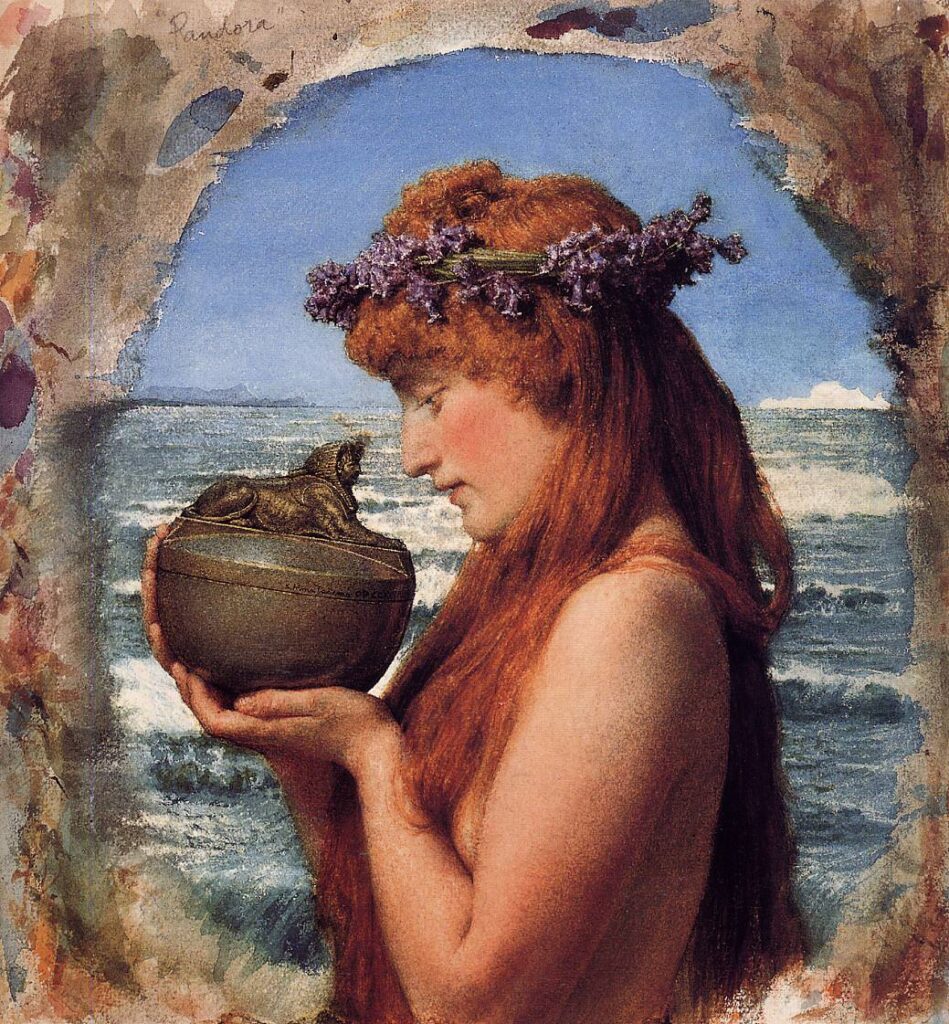
Lawrence Alma-Tadema, Pandora About to Open Her Box, 1881, private collection.
It’s easy to see Pandora in a wholly negative light. But on the contrary, her decision to open the box may just have saved humanity instead. She could be another hero stuck in an impossible situation, like Persephone, or even the Biblical Eve. After all, would there be purpose to be found in a world of eternal Paradise? Isn’t life only fully appreciated when it includes both life and darkness? And doesn’t opening a mysterious box make a far better story than leaving it sealed forever?
So ends our journey through mythological heroes. But the tales don’t end here, of course. So many of these figures are interconnected, and new comparisons are just waiting to be drawn. Your individual take on a hero could be the next source of artistic inspiration!
Prometheus: Stealing Fire from the Gods, National Museums Liverpool website. Accessed 18 February 2024.
Marian Vermuelen, Prometheus Bound: The Tragic Story Told Through 17 Artworks, 2023, The Collector. Accessed 18 February 2024.
DailyArt Magazine needs your support. Every contribution, however big or small, is very valuable for our future. Thanks to it, we will be able to sustain and grow the Magazine. Thank you for your help!